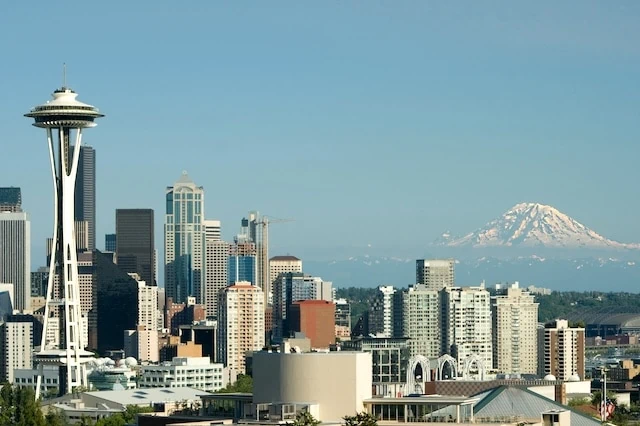Does it feel like home prices around you have reached absurd heights?
It might not just be a feeling. The average price for a home remains elevated even after several months of easing, and with interest rates still sitting around multi-decade highs, the actual cost of buying a home isn’t just uncomfortably aloft—for many, it’s simply out of reach.
But just how badly prospective homebuyers are feeling the pinch largely rests on where they live.
If you’re looking to move within your current city or to a new city (or if you’re just curious about the state of the housing market), read on. Today, I’ll be looking at the most expensive U.S. cities to buy a house.
Table of Contents
Methodology (Part 1)

Data for this article used to identify these cheapest cities to buy a house come from the Council for Community and Economic Research (C2ER), which among other things provides research and data about the cost of living across the U.S.
Specifically, I’m looking at data from their Cost of Living Index, which measures relative price levels for consumer goods and services—namely, grocery items, health care, housing, transportation, utilities, and miscellaneous goods—in 276 participating urban areas. And I’m winnowing the selection down to U.S. cities with at least 100,000 residents as of the 2022 census.
Average Mortgage Principal and Interest
To determine which cities offer the most expensive housing, we’ve relied on the city-wide averages for the average principal and interest (P+I) paid for new homes. This C2ER data point is based on homes with the following specifications:
— Newly built (not previously occupied)
— Single-family detached
— 2,400 square feet (not including garage)
— Full purchase price
— “Good” or “very good” construction quality based on the Marshall & Swift method
However, P+I doesn’t tell the whole story, which is why I also looked at a few other statistics that help paint a picture of a city’s general homeownership affordability (or lack thereof):
Median Household Income and City Population
The income figures cited in this article come from the Bureau of Labor Statistics’ Current Population Survey assessment of median household income by city from 2022, the most recent year available as of the time of publication. Likewise, this same survey provides information about each city’s population.
Methodology (Part 2)

Cost of Living vs. the National Average
This data point, provided by C2ER, represents the percentage difference between each city and the calculated national average of the total cost-of-living index.
Average Percentage of Income Spent on P+I
This calculation is a combination of the three data points above. We take the median household income for each city and divide it by 12 times the average monthly P+I. This provides a percentage that shows the amount of median household income that goes toward the average P+I.
Regarding the Commingling of Median Household Income and Mean Principal and Interest
One wonky data item I’d like to point out is a calculation we provide detailing the percentage of median household income as a percentage of the average principal and interest (P+I) paid on a mortgage. You’ll notice that some of these figures are unsustainably high. That’s due to the use of median household income provided by the Bureau of Labor Statistics (BLS) and the mean (average) principal and interest balance paid on a mortgage in these cities.
In an ideal world, we’d have a perfect match between either median household income and median mortgage payment or mean household income and mean mortgage payment. Given the limitations of the data sets we’ve used, we’re forced to marry two sets of data points that can skew how certain calculations work. As a for-instance, using median household income and mean P+I generally results in a higher average % income spent on P+I than reflects reality.
Most Expensive Housing Markets

Home prices aren’t the only factor to consider. An expensive house and/or a high cost of living becomes a lot more achievable if you can find a job that pays well—and in many cities with high-priced homes, those jobs are plentiful.
Read on as I show you the cities with the highest costs of buying a new home, based on C2ER data and the above methodology.
These cities are listed in order of average monthly P+I (from lowest to highest).
10. Seattle, Washington

— Average monthly P+I: $4,924
— Median annual household income: $116,068
— Population: 749,256
— Average % income spent on P+I: 50.9%
— Cost of living vs. U.S. average: +44.6%
The seaport city of Seattle is the most populous city in the state of Washington. It has a reputation of being one of America’s rainiest cities—while the overall yearly precipitation isn’t a spectacular amount, it does average 152 days a year with at least a little drizzle. All that rain keeps the city’s landscape lush, though; indeed, its high number of evergreen trees and other greenery are what earned Seattle its nickname of “The Emerald City.”
Past that, Seattle is known for the Space Needle, coffee (it’s the home of Starbucks), grunge rock, and Frasier. It’s also the birthplace of Boeing, home to Amazon’s headquarters, and just a hop, skip, and a jump from Microsoft’s corporate HQ.
Seattle might be the “cheapest” place to buy a house on this list, but it’s hardly cheap. Principal and interest costs the owner of a 2,400-square-foot home more than $4,900 each month. As I mentioned above in the methodology, the average percent of income spent on P+I is somewhat misleading because of the types of data available, but Seattle residents still do cough up quite a bit on homeownership.
In fact, you’ll spend quite a bit no matter whether you buy or rent—housing costs are more than twice the national average. Healthcare, transportation, and grocery costs also significantly contribute to a total cost of living that’s nearly 45% higher than what you can expect across the country. If there’s any consolation, median household income is nearly 55% above the U.S. average; even minimum-wage workers earn one of the highest hourly rates in the country.
Related: 7 Best Banks for Real Estate Investors + Landlords
9. San Diego, California

— Average monthly P+I: $5,169
— Median annual household income: $98,657
— Population: 1,381,162
— Average % income spent on P+I: 62.9%
— Cost of living vs. U.S. average: +42.0%
In contrast to Seattle, “America’s Finest City” is known for its perpetually pleasant weather—as the old saw goes, “the easiest job in the world is a weatherman in San Diego.”
This coastal city boasts dozens of international cuisines, but Mexican fare is king. Thanks to its proximity to the U.S.-Mexico border, you can’t walk five feet without bumping into life-changing tacos or mariscos.
There’s plenty you can do to build up an appetite, too. The city is home to the famous San Diego Zoo (the only one outside Australia to house platypuses!), SeaWorld, Torrey Pines State Natural Reserve, the USS Midway Museum, and the Maritime Museum of San Diego.
Like with Seattle, San Diego residents spend roughly twice as much on housing than the national average, regardless of whether they’re renting or buying. But owning a home is particularly pricy, at nearly $2,800 per month more than the average of all cities within C2ER’s dataset. On top of that, groceries, transportation, and miscellaneous goods and services all cost significantly more, leading to an overall cost of living that’s 42% more than the average city.
Related: 5 Best Vanguard Dividend Funds [Low-Cost Income]
8. Arlington, Virginia

— Average monthly P+I: $5,381
— Median annual household income: $137,387
— Population: 234,000
— Average % income spent on P+I: 47.0%
— Cost of living vs. U.S. average: +36.8%
Arlington, which sits directly across the Potomac River from Washington, D.C., technically isn’t a city. It’s instead an “urban county”—one with no incorporated cities or towns within its limits. It does have 10 neighborhoods, though, as well as 1,100 acres of parks and open space. Indeed, there are 157 parks and nature centers, providing plenty of opportunities to get fresh air.
Arlington, like nearby Washington, is home to numerous memorials, including Arlington National Cemetery, Air Force Memorial, Military Women’s Memorial, Marine Corps War Memorial (Iwo Jima), and the National 9/11 Pentagon Memorial. But it’s perhaps best known as the home of the Pentagon—the headquarters for the U.S. Department of Defense.
No wonder, then, that government and service sectors compose the largest chunk of Arlington’s jobs. And that might explain both the much-higher-than-average median annual household income, as well as the extremely high cost of buying a home.
Arlington’s housing costs are also more than double the national average, including average principal and interest costs that are nearly $3,000 more per month than the U.S. mean. Other costs of living are plenty higher, too, including healthcare, groceries, and miscellaneous goods and services, though utility costs and transports are roughly on par. Again, though, chances are you’ll be well-compensated—the median annual household income in Arlington is nearly $63,000 higher and ranks No. 1 on this list of cities.
Related: 9 Monthly Dividend Stocks for Frequent, Regular Income
7. Washington, D.C.

— Average monthly P+I: $5,844
— Median annual household income: $101,722
— Population: 671,803
— Average % income spent on P+I: 68.9%
— Cost of living vs. U.S. average: +46.8%
Washington, D.C., the capital city and federal district of the United States, is positioned across the Potomac River from Virginia, and it shares land borders with Maryland.
Perhaps no other city holds more American political and historical significance than Washington. It’s home to the White House, Capitol Building, and Supreme Court Building. It’s brimming with memorials, including the Washington Monument, Lincoln Memorial, Jefferson Memorial, and numerous war memorials. It’s also home to the famous Smithsonian group of museums (and the National Zoo!), all of which are free to visit.
This vibrant city is bustling year-round; there’s always something to see. Among its most prized annual events are the early-spring National Cherry Blossom Festival and the winter National Christmas Tree Lighting.
Washington boasts a high median annual household income in the low six digits, but it also requires an average monthly P&I (on a 2,400-square-foot home) that’s more than $3,400 above the U.S. mean. Housing costs are by far and away the most impactful factor in Washington’s high cost of living, though all other measures—groceries, utilities, transportation, health care, and miscellaneous goods and services—are anywhere from 5% to 15% above the national average.
Like Young and the Invested’s Content? Be sure to follow us.
6. Los Angeles, California

— Average monthly P+I: $5,847
— Median annual household income: $76,244
— Population: 3,822,238
— Average % income spent on P+I: 92.0%
— Cost of living vs. U.S. average: +48.9%
Los Angeles is California’s biggest city and the second-most populous city in the U.S. It’s also home to the stars—Hollywood, which is a neighborhood that’s mostly contained within Los Angeles, contains several notable film studios, including Paramount Pictures, Sony Pictures, Universal Pictures, Walt Disney Studios, Warner Bros., and many more.
But there’s more to L.A. than that. The metropolitan area is chock full of professional sports teams, including two teams each in the NFL, NBA, MLB, NHL, and MLS, as well as the WNBA’s Los Angeles Sparks. It’s also teeming with colleges—it’s best known for the University of California, Los Angeles (UCLA), but it also has a pair of California State University institutions (Los Angeles and Northridge), as well as several private colleges and a community college system.
And on top of all that, L.A. boasts the Griffith Observatory, the Getty Center, the Los Angeles County Museum of Art, Rodeo Drive … and it’s one of the best food cities in the U.S.
According to C2ER data calculations, Los Angeles has the third-highest average percentage of income spent on P&I across all cities, at 92%. But again, this is where median income and mean P&I data clash—median income is only looking at the midpoint, which minimizes many residents’ much higher incomes. Non-Census data puts the average annual household income at closer to $107,000. Also worth noting: In many situations, people bought houses decades ago when the home price was just a fraction of what the housing market deems those places are worth today.
Still, that only means Los Angeles isn’t impossibly expensive—but it’s still a very expensive place to live. Transportation is nearly 25% higher than the national average, while groceries, utilities, health care, and miscellaneous goods and services are also more expensive.
Editor’s Note: C2ER data for Los Angeles also takes Long Beach into account.
Related: Federal Tax Brackets and Rates
5. Orange County, California

— Average monthly P+I: $6,554
— Median annual household income: $109,361
— Population: 3,151,184
— Average % income spent on P+I: 71.9%
— Cost of living vs. U.S. average: +50.3%
C2ER data looks at “urban areas”—in most cases, these are individual cities, but there are a few outliers. For instance, it could be a pair of cities considered to be one area, an “urban county” like Arlington, Virginia, or in this case, all of Orange County.
The “O.C.”—yes, the setting of the so-named popular teen drama series from the early 2000s—is the second most densely populated county in California, behind only San Francisco County. It’s bordered on the southwest by the Pacific Ocean, and within it are several cities, including Anaheim, Irvine, and Santa Ana.
The most famous attraction within Orange County is the Disneyland Resort, which predates Florida’s Walt Disney World by 16 years. Other popular attractions include Knott’s Berry Farm (a farm long ago, but now an amusement park), Huntington Beach, and Laguna Beach.
Orange County’s average monthly P+I is more than $4,100 than the national average, and by far and away the greatest contributor to the area’s pricey overall cost of living. It also has much higher-than-average transportation, grocery, and miscellaneous goods and services costs, though interestingly, utilities and health care costs are below-par. OC employers do provide much higher compensation, however, with a median annual household income that’s close to $110,000.
Related: Best Vanguard Retirement Funds for an IRA
4. San Francisco, California

— Average monthly P+I: $7,224
— Median annual household income: $136,689
— Population: 808,437
— Average % income spent on P+I: 63.4%
— Cost of living vs. U.S. average: +70.0%
San Francisco has numerous claims to fame, including the Golden Gate Bridge, Alcatraz Island, Fisherman’s Wharf, great sourdough bread, and even the row of Victorian houses dubbed “the Painted Ladies.” And while you’re there, you can ride the cable cars, take in a Giants game at gorgeous Oracle Park, or drive up the Twin Peaks for an incredible 360 view.
Of course, San Francisco is basically synonymous with technology—scores of tech companies are headquartered either in the city itself, or more commonly, in the San Francisco Bay Area. Apple, Alphabet (Google), Meta (Facebook), Intel, and Nvidia, are just a handful of the large tech names that have nested in the area—and many more not based in San Francisco have a significant office presence.
Unsurprisingly, these firms—and the extremely high-paying jobs they provide—contribute to an extremely high median annual household income of $136,689 that’s some $62,000 more than the national median. But home prices are sky-high, too; principal and interest on a 2,400-square-foot home is nearly triple the U.S. average. Meanwhile, groceries, utilities, transportation, health care, and miscellaneous goods and services are all between 25% and 35% higher than the norm.
Related: 12 Best Apps That Give You Money for Signing Up [Free Money]
3. Honolulu, Hawaii

— Average monthly P+I: $8,009
— Median annual household income: $99,816
— Population: 995,638
— Average % income spent on P+I: 96.3%
— Cost of living vs. U.S. average: +80.3%
Honolulu, the capital of Hawaii, sits in the midst of a tropical paradise perfect for water sports, enjoying nature, or just relaxing on the beach. Volcanoes and waterfalls are literally part of the landscape.
But if you’re envisioning an episode of Gilligan’s Island, Honolulu is far more than that. Those who prefer plentiful restaurants, shopping, and other amenities can find plenty of that across the city, such as in the resort-laced downtown Waikiki.
Just a few of Honolulu’s popular attractions include the Pearl Harbor National Memorial and USS Arizona Memorial, Diamond Head State Monument, the Battleship Missouri Memorial, and the Byodo-In Temple. Fitness lovers can travel to enjoy The Great Aloha Run, the Honolulu Marathon, and the Honolulu Triathlon (an Olympic distance triathlon).
But before you pack your bags and set sail for paradise, remember: Paradise ain’t cheap.
Honolulu has the highest cost of living for any city for which C2ER has data—a full 80% more than the national average. It also has a sky-high average percent of income spent on principal and interest (again, the data is skewed … but Honolulu is still expensive). A 2,400-square-foot house will cost you a hair over $8,000 per month, which is easily more than triple the national mean. Utilities are sky-high too, at 51% more than what an average American pays, as are transportation costs, which are 35% higher.
Like Young and the Invested’s Content? Be sure to follow us.
2. New York (Manhattan-Brooklyn-Queens), New York

— Average monthly P+I: $8,562
— Median annual household income: $76,607 (NY Metro Area)
— Population: 8,335,897 (NY Metro Area)
— Average % income spent on P+I: 138.4%
— Cost of living vs. U.S. average: +75.0%
New York City is America’s biggest city by population, at more than 8 million residents across its five boroughs—the Bronx, Brooklyn, Manhattan, Queens, and Staten Island.
NYC is home to some of the nation’s most iconic destinations, including the Statue of Liberty, Times Square, Broadway, Central Park, the Metropolitan Museum of Art, and the Brooklyn Bridge. It’s home to the New York Yankees, Mets, Knicks, Nets, Islanders, Rangers, NYCFC, and Liberty. (And if your favorite New York team is missing from this list, that’s because they play in New Jersey.) It also hosts one of tennis’s four majors—the U.S. Open, in Queens’ USTA Billie Jean King National Tennis Center.
It’s home to countless cultures and cuisines and so much more, from the United Nations to the best steak you’ll ever have.
And it’s also home to some truly breathtaking home prices.
New York City is covered by multiple C2ER data sets, meaning the numbers above are just an average of several boroughs. For instance, the average P+I on a 2,400-square-foot home in Queens is actually $5,236 per month, while it’s a whopping $13,535 in Brooklyn. So between that, and the natural skew of using median annual household income, no—no, people aren’t spending nearly 140% of their income to afford housing in NYC.
But it’s still very, very expensive to live there.
Housing costs (whether it’s to buy or rent) are well more than triple the national average, which is the overwhelming factor in New York City’s pricey cost of living. A few costs aren’t bad—utilities are at least close to “normal” prices—but in general, you’re still paying more for just about anything you want to buy in NYC.
Related: 50+ Best Money-Making Apps That Pay You Real Money
1. San Jose, California

— Average monthly P+I: $8,581
— Median annual household income: $136,010
— Population: 971,233
— Average % income spent on P+I: 75.7%
— Cost of living vs. U.S. average: +74.4%
What city could possibly have higher housing costs than New York City?
San Jose, California.
This Bay Area city sits southeast of San Francisco and in the center of Santa Clara County. As I mentioned in discussing San Francisco, the Bay Area is America’s seat of technology—and San Jose is actually called the “capital of Silicon Valley.”
But it’s not just cookie-cutter skyscrapers here. San Jose has an impressive cityscape, but also an array of vividly styled neighborhoods, boasting all sorts of architectural influences, from Spanish Colonial to Mediterranean Revival to Neoclassical and more. It’s home to the San Jose Museum of Art and the Tech Museum of Innovation. But it also has plenty of green spaces, such as the Japanese garden in Kelley Park, Municipal Rose Garden, and Overfelt Gardens.
Just like with San Francisco, San Jose’s high housing costs are well known. Indeed, LendingTree analyzed data from the U.S. Census Bureau’s American Community Survey and found that million-dollar homes make up a majority share of homes in both San Francisco and San Jose.
The monthly P+I of $8,581 for a 2,400-square-foot home is the highest on this list. (Rent isn’t exactly cheap, either, at $3,652 per month.) Utilities and transportation are both 30% costlier than the national average. Grocery, health care, and miscellaneous goods and services all cost more, too.
The only saving grace is an extremely high median annual household income—which, like San Francisco, you can chalk up to the glut of tech jobs around the city.
Related: 7 Best Wealth + Net Worth Tracker Apps [View All Your Assets]
Related: 6 Best Stock Recommendation Services [Stock Picking + Tips]

Stock recommendation services are popular shortcuts that help millions of investors make educated decisions without having to spend hours of time doing research. But just like, say, a driving shortcut, the quality of stock recommendations can vary widely—and who you’re willing to listen to largely boils down to track record and trust.
The natural question, then, is “Which services are worth a shot?” We explore some of the best (and best-known) stock recommendation services.
Related: 12 Best Long-Term Stocks to Buy and Hold Forever
As even novice investors probably know, funds—whether they’re mutual funds or exchange-traded funds (ETFs)—are the simplest and easiest ways to invest in the stock market. But the best long-term stocks also offer many investors a way to stay “invested” intellectually—by following companies they believe in. They also provide investors with the potential for outperformance.
So if your’e looking for a starting point for your own portfolio, look no further. Check out our list of the best long-term stocks for buy-and-hold investors.
Related: Best Target-Date Funds: Vanguard vs. Schwab vs. Fidelity

Looking to simplify your retirement investing? Target-date funds are a great way to pick one fund that aligns with when you plan to retire and then contribute to it for life. These are some of the best funds to own for retirement if you don’t want to make any investment decisions on a regular basis.
We provide an overview of how these funds work, who they’re best for, and then compare the offerings of three leading fund providers: Vanguard, Schwab, and Fidelity.
Related: 9 Best Monthly Dividend Stocks for Frequent, Regular Income

The vast majority of American dividend stocks pay regular, reliable payouts—and they do so at a more frequent clip (quarterly) than dividend stocks in most other countries (typically every six months or year).
Still, if you’ve ever thought to yourself, “it’d sure be nice to collect these dividends more often,” you don’t have to look far. While they’re not terribly common, American exchanges boast dozens of monthly dividend stocks.
Please Don’t Forget to Like, Follow and Comment

Did you find this article helpful? We’d love to hear your thoughts! Leave a comment with the box on the left-hand side of the screen and share your thoughts.
Also, do you want to stay up-to-date on our latest content?
1. Follow us by clicking the [+ Follow] button above,
2. Subscribe to The Weekend Tea, our weekly newsletter to read more about investing, spending, taxes, and more, and
3. Give the article a Thumbs Up on the top-left side of the screen.
4. And lastly, if you think this information would benefit your friends and family, don’t hesitate to share it with them!






